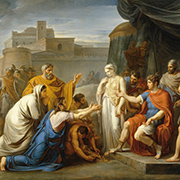Cavalli's opera "Scipione Affricano" offers many possibilities for realisation on stage. In addition to the love plot, the opera also deals with the themes of freedom and slavery. The new edition which is part of the critical edition “Francesco Cavalli-Opere” offers opera houses a dependable basis.
In 1662, Cavalli’s career was at its zenith. The two dozen operas he had written for Venice had helped establish Venice as the world’s first operatic superpower. He had also been commissioned to write operas for the courts of Milan and Florence, plus a monumental spectacle for the wedding of Louis XIV (“Ercole amante”).
“Scipione Affricano” (Venice 1664), Cavalli’s first opera after returning from France, was one of his most successful compositions. In a period that valued new works over familiar ones, Scipione was one of a handful of operas to live on after its premiere season: it was revived eight times and chosen to inaugurate Rome’s Teatro Tordinona in 1671. This opera also launched the career of one of the century’s most celebrated singers, who so epitomized the role of Siface that he took this as his stage name.
Cavalli’s collaborator, Nicolò Minato, was inspired by historical accounts of the life of the Roman general Scipio, whose defeat of Carthage in 202 BCE earned him the honorary agnomen “Africanus.” Scipio’s life was full of characters ripe for development on the operatic stage: Queen Sophonisba, who drank poison rather than go to Rome as Scipio’s prisoner, and a female captive whom Scipio nobly declined to bed once he learned that she was to be married. Minato developed these episodes as love triangles: one poignant, the other comic. Yet Minato’s libretto is more than a love story: it also delves into the issue of liberty vs. slavery. This topic is particularly charged for us today: a plot about a white imperialist power subjugating another culture raises innumerable questions. “Scipione Affricano” allows us to view these issues from multiple perspectives and ponder the bitter irony that one of the singers for the premiere was, in fact, a Black slave.
In setting Minato’s libretto, Cavalli drew upon the lyrical gifts that have made operas like “La Calisto” and “Giasone” so popular today. The role of Siface shares a type of mellifluous poignancy with that of Endimione in La Calisto. Yet in other ways Cavalli was reinventing himself. “Scipione Affricano” shows the composer embracing aspects of his two years in France, and responding to musical changes that, in the 1660s, were rapidly altering the face of Italian opera: the growing dominance of arias, a clearer sense of aria organization, and increased interplay between voice and instruments.
The plot
“Scipione Affricano” stages two famous episodes in the life of the Proconsul: the episode of the “Continence of Scipio”, and the story of the unfortunate lovers Sofonisba and Masinissa, the beautiful queen of Numidia and the passionate African leader, ally of Scipio.
The “Continence of Scipio” is a well-known story: following the conquest of New Carthage in Iberia, Ericlea, a beautiful girl already betrothed to Luceio, prince of the Celtibers, is given to Scipio. Scipio, with a noble gesture, returns the young woman to her fiancé.
The episode of Sofonisba and Masinissa, on the other hand, concerns Carthage in Africa. Having defeated the city, Scipio imprisons Siface, king of Numidia. Masinissa, fascinated by the beauty of Siface's wife, Sofonisba, conspires in order to have the woman to himself. But for Scipione Sofonisba is a booty of war, and for this reason he claims her, thus creating a conflict with his ally.
The drama ends with the reconciliation of the two couples, Ericlea-Luceio and Sofonisba-Siface.
The Musical Edition
The first goal of this edition is a practical one: to develop a version of the opera suited to the needs of both professional and student performers, and thereby enable modern audiences finally to experience this magnificent opera.
A second, more scholarly goal is to reconstruct the opera’s complete performance history, from its genesis to its last revival. Throughout history, most operas were in a continual state of flux, constantly responding to the needs of singers, impresarios, and audiences; often the final result was substantially different than the first version. For many opera lovers, this very messiness—the backstage negotiations, disasters, and last-minute solutions—is an endless source of fascination. Unfortunately, “Scipione Affricano’s” autograph and performance materials are lost; the primary musical source is a clean copy that Cavalli had professionally copied for his personal library. We are left, then, with an inherent contradiction between a highly fluid performance tradition on the one hand, and on the other, a written tradition that appears to freeze the musical text of the opera in a flourish of beautiful calligraphy.
Furthermore, this manuscript is full of errors and puzzles; it cannot be performed without editorial intervention. Yet the very anomalies that make it problematic in one respect make it invaluable in another. In effect, these serve like tiny gaps in the curtain, affording occasional glimpses of what was going on backstage, and helping us to reconstruct, if imperfectly, the complicated musical genesis of “Scipione Affricano”.
The Musical Edition hews as closely as possible to Cavalli’s manuscript, with minor adjustments. An amply documented appendix reconstructs earlier versions of 21 arias. Other appendices print the surviving additional music from revivals in Rome and Venice. The edition is framed by a substantial Introduction, covering the drama, the musical style, the composition, premiere, and revivals, and a guide for performance today, plus a detailed “decoding” of the sources. In short, this edition provides a conduit into “Scipione Affricano’s” fascinating and complex performing history—one where, among a large cast of impresarios, singers, patrons, and later revisers, Minato and Cavalli played the leading roles.
Jennifer Williams Brown / Sara Elisa Stangalino
(August 2022)



